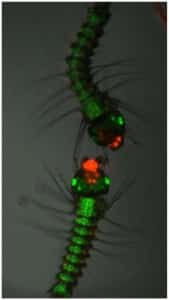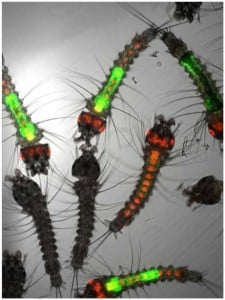Mosquito Transgenesis

Drosophila transgenesis has been instrumental for the understanding of many aspects of the fruit fly biology, allowing over-expression of gene of interests —in a tissue-specific and timed manner thanks to the Gal4/UAS system and its refinements—; transposon-mediated mutagenesis for the discovery of key player genes in a given biological process; expression of proteins of interest fused to reporters such as the Green Fluorescent Protein (GFP) to follow their cellular fate; fine genetic manipulations such as gene knockout; targeted gene knockdown by transgenic RNAi…
Similarly, transgenesis can be expected to help unravel key processes in Anopheles biology including that of vector/Plasmodium interactions. Thus, we are particularly keen on exploiting Anopheles transgenesis to address our biological queries. In the future, transgenic mosquitoes may even help fight malaria, as transgenesis could also be used to render mosquitoes resistant to Plasmodium parasites or in strategies designed to decrease mosquito vector populations, such as the Sterile Insect Technique (SIT).


We are interested in exploring the potential of all these aspects of mosquito transgenesis. Therefore, we worked hard to establish A. gambiae transgenesis in our laboratory and are now able to produce transgenic mosquitoes in a routine fashion. Key factors in this success were the optimization of each step of transposon-mediated transgenesis; the establishment of robust attP docking lines for phage PhiC31-mediated transgenesis and the construction of efficient helper plasmids; the use of automated larval sorting to distinguish between mosquito larvae carrying 0, 1 or 2 copies of a given transgene in order to rapidly generate stable homozygous lines and monitor subsequent transgene stability; and the use of multiple transgenesis selection markers to gain time by generating several distinct transgenic lines simultaneously.
With these tools at hand, we are currently (i) testing the effect of various transgenes on the outcome of a Plasmodium infection; (ii) establishing targeted mutagenesis of the Anopheles gambiae genome using TALEN synthetic endonucleases; (iii) setting up automated protocols to generate large populations of mosquitoes carrying the desired transgenes, or single-sex mosquito populations carrying no transgene at all. Pure male populations obtained in this manner may be used in SIT or in population replacement intervention schemes, aimed at increasing the frequency of disease resistant mosquitoes in the general mosquito population.

In the future, we will further explore how transgenesis can help obtain mutant (but non-transgenic) mosquitoes that are unable to transmit disease. For example, bringing small modifications to mosquito proteins that Plasmodium needs to colonize its vector could render the vector Plasmodium-resistant. The transgenes used to obain these genetic modifications can be subsequently eliminated by genetic crosses and selection, and the obtained non-transgenic, disease-resistant mutant lines may be evaluated for population-replacement intervention strategies.
 Intranet
Intranet Access
Access Contact
Contact